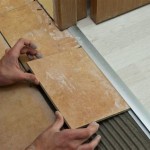How To Install Ceiling Tiles In A Basement
Installing ceiling tiles in a basement can significantly improve the aesthetics, acoustics, and insulation of the space. A suspended ceiling, also known as a drop ceiling, is a popular choice for basements due to its ease of installation and accessibility to utilities such as wiring and plumbing. This article provides a comprehensive guide on how to install ceiling tiles in a basement, covering essential tools, materials, preparation steps, and the installation process itself.
Before embarking on the project, a clear understanding of the requirements and procedures is crucial. This ensures a successful installation that meets both functional and aesthetic needs. Careful planning and execution will result in a professional-looking ceiling that enhances the basement environment.
Planning and Preparation
Proper planning is the cornerstone of any successful ceiling tile installation. This phase involves assessing the basement space, determining the necessary materials, and preparing the area for installation. Neglecting this step can lead to errors and delays later in the process.
First, measure the dimensions of the basement. This includes the length, width, and height of the room. These measurements will be used to calculate the amount of material needed, including ceiling tiles, grid components (main runners, cross tees, and wall angles), and fasteners. Accurate measurements are essential to minimize waste and ensure a proper fit.
Next, determine the desired ceiling height. Ideally, the ceiling should be low enough to conceal pipes and ducts but high enough to maintain adequate headroom. A minimum of 7 feet is generally recommended for finished basements. Use a laser level or a chalk line to mark the desired ceiling height around the perimeter of the room. This line will serve as a reference for installing the wall angles.
After determining the ceiling height, inspect the existing basement ceiling for any obstructions such as pipes, ducts, or wiring. Plan the grid layout to avoid these obstacles. If necessary, relocate or modify these utilities before proceeding with the installation. This may involve hiring a qualified professional to ensure compliance with building codes and safety standards.
Choosing the right type of ceiling tile is also an important consideration. Tiles are available in various materials, including mineral fiber, fiberglass, and metal. Each material offers different properties in terms of sound absorption, fire resistance, and moisture resistance. Select tiles that are suitable for the basement environment and meet any applicable building codes. Consider factors such as humidity levels and potential for water damage when making your selection.
Gather all the necessary tools and materials before starting the installation. This will help to streamline the process and prevent delays. Essential tools include a measuring tape, laser level or chalk line, utility knife, tin snips, drill, screw gun, safety glasses, and gloves. Materials include ceiling tiles, main runners, cross tees, wall angles, suspension wire, and fasteners.
Finally, prepare the basement for installation by removing any furniture or other items from the room. Cover the floor with drop cloths to protect it from debris and dust. Ensure adequate ventilation by opening windows or using a fan. Wear safety glasses and gloves to protect yourself from dust and sharp edges.
Installing the Grid System
The grid system forms the framework that supports the ceiling tiles. It consists of wall angles, main runners, and cross tees. Proper installation of the grid system is crucial for ensuring a level and stable ceiling.
Start by installing the wall angles around the perimeter of the room. These angles are typically attached to the wall using screws or nails. Align the top edge of the wall angle with the reference line that was marked earlier. Ensure that the wall angles are level and securely fastened to the wall. Use shims if necessary to compensate for any unevenness in the wall surface. Overlap the wall angles at the corners to create a neat and professional finish.
Next, install the main runners. These are the longest grid components and they run parallel to each other across the room. The spacing between main runners depends on the size of the ceiling tiles. For example, 2x4 foot tiles typically require main runners to be spaced 4 feet apart. Use a layout square to ensure that the main runners are perpendicular to the wall angles.
Suspend the main runners from the existing ceiling using suspension wire. Attach the suspension wire to the main runners at regular intervals, typically every 4 feet. Secure the other end of the suspension wire to joists or other structural members above the ceiling. Ensure that the suspension wire is taut and that the main runners are level. Adjust the wire as needed to achieve a level grid.
Once the main runners are in place, install the cross tees. These are shorter grid components that run perpendicular to the main runners. The spacing between cross tees also depends on the size of the ceiling tiles. For example, 2x4 foot tiles typically require cross tees to be spaced 2 feet apart. Insert the ends of the cross tees into the slots on the main runners. Ensure that the cross tees are level and securely attached to the main runners.
Inspect the entire grid system to ensure that it is level, square, and securely fastened. Make any necessary adjustments before proceeding to the next step. A well-installed grid system is essential for a professional-looking ceiling.
Installing the Ceiling Tiles
With the grid system in place, the final step is to install the ceiling tiles. This involves carefully placing the tiles into the grid and making any necessary cuts to fit around obstructions or at the edges of the room.
Start by installing the full-size tiles in the center of the room. Carefully lift each tile and position it into the grid. Ensure that the edges of the tile are aligned with the grid components. Gently lower the tile into place, making sure that it is fully seated in the grid. Avoid pushing the tile too hard, as this could damage it.
When you reach the edges of the room or encounter obstructions such as pipes or ducts, you will need to cut the tiles to size. Use a utility knife and a straight edge to make clean, accurate cuts. Measure the required size and shape carefully before cutting. It is always better to cut the tile slightly larger than necessary and then trim it down to the correct size. Wear safety glasses and gloves to protect yourself from sharp edges.
For irregular shapes or curves, you may need to use a template or a jigsaw. Trace the shape onto the tile and then carefully cut it out using the appropriate tool. Take your time and make sure the cuts are clean and accurate. A poorly cut tile can detract from the overall appearance of the ceiling.
When installing cut tiles, make sure that the cut edge is facing the wall or obstruction. This will help to conceal any imperfections in the cut. Use small pieces of scrap tile to fill in any gaps or cracks. Secure the cut tiles in place using adhesive or fasteners if necessary.
Continue installing the tiles until the entire ceiling is covered. Inspect the finished ceiling for any gaps, unevenness, or other imperfections. Make any necessary adjustments to ensure that the ceiling is level and visually appealing. Clean up any debris or dust from the floor and dispose of the waste materials properly.
Installing recessed lighting, speaker systems, or air vents may be necessary. Cut openings in the ceiling tiles with appropriate dimensions and shapes to accommodate the items. Secure these fixtures according to the manufacturer's advice for secure and safe installation. Ensure that wires are safely and accurately connected to the grid system to guarantee that the electrical components function correctly.
Installing a ceiling in a basement is a significant task that improves the appearance and functionality of the finished space. Selecting an ideal space for the grid and tile alignment, and making sure that all the electrical components are in place ensures a successful project.

Drop Ceiling Tile Installation Acoustic Suspended

Diy How To Update Old Ceiling Tile Pink Little Notebookpink Notebook

How To Easily Install A Drop Ceiling Ron Hazelton

Ceiling Tile Installation Ceilings Armstrong Residential

How To Install A Drop Ceiling Diy For Beginners

Drop Ceiling Tiles Installation Tips Diy Family Handyman

Basement Ceiling Ideas Installation

How To Install A Drop Ceiling

Finish Your Basement With Drop Ceiling Tiles Decorative Inc

A Drop Ceiling That Looks Better Than Drywall How To Install In Basement Diy
Related Posts








